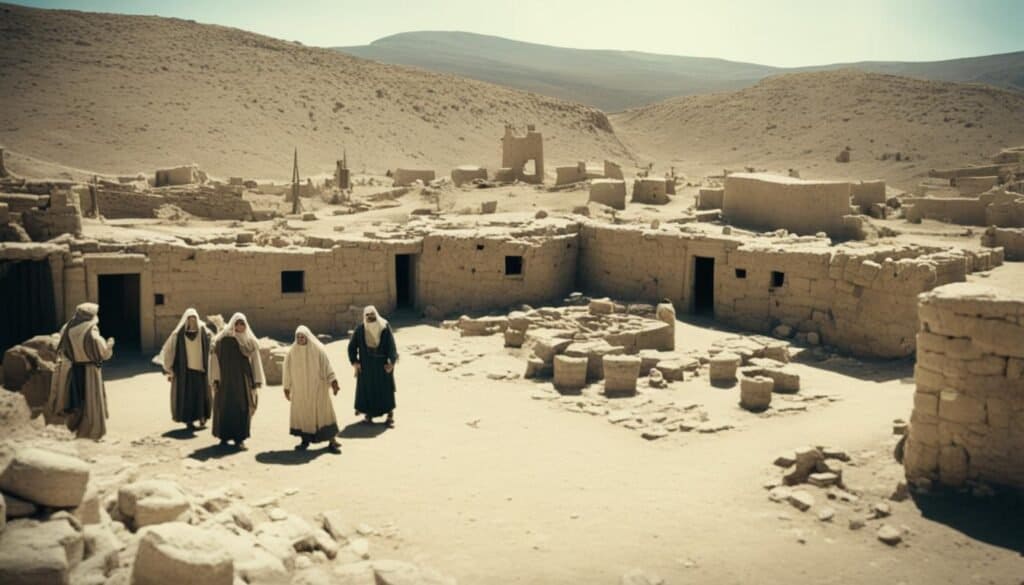Leprosy in the Bible is more than just a physical disease. It shows us deep spiritual truths and how society views illness. We will look into the biblical definition of leprosy and its spiritual significance. This disease is part of powerful stories about faith, healing, and mercy. These stories teach us lessons that are still important today.
By exploring the history and spiritual meaning of leprosy, we start a journey of discovery. We’ll see how leprosy is shown in the Bible, the lessons it teaches us, and what it says about our lives.
Key Takeaways
- The biblical definition of leprosy includes both physical and spiritual aspects.
- Leprosy shows how society reacted to illness and fear in the past.
- Important stories talk about healing, faith, and showing compassion.
- Learning about leprosy helps us think deeply about our own and others’ struggles.
- This look into leprosy teaches us lessons that still matter today.
The Biblical Definition of Leprosy
The biblical definition of leprosy is complex and multifaceted. Leviticus 13:2-3 gives us a clear view of this disease. It lists various skin conditions that could be seen as leprosy. This Leviticus 13:2-3 interpretation shows the challenges in diagnosing the illness. It tells us that not all skin issues were the same. Priests had to carefully check if someone was truly afflicted.
Leviticus 13:2-3 Interpretation
In Leviticus 13:2-3, people with certain skin issues had to see a priest. The priest’s decision was crucial for the person’s social and spiritual life. The text lists many symptoms, making the definition of leprosy complex. This variety can cause confusion about its seriousness and effects.
Common Misconceptions about Leprosy
Many think leprosy is just a physical disease. But it also had deep social and spiritual effects. People with leprosy were often shunned, adding to their suffering. Understanding this helps us see the full impact of leprosy.
Looking at these points helps us understand leprosy’s role in the Bible and its effects on people. The deep meanings in the Leviticus 13:2-3 interpretation and how society viewed leprosy still affect today’s health and community attitudes.
Significance of Leprosy in Biblical Times
Leprosy in biblical times was a big deal, affecting people’s lives in many ways. It was not just a physical illness but also had deep social, cultural, and spiritual impacts. Let’s explore how it affected people’s lives.
Social and Cultural Implications
People with leprosy were often shunned, seen as unclean. This showed how much fear and confusion there was about the disease. Being isolated meant they couldn’t be part of their families or communities anymore.
This led to a deep sadness and loneliness for those affected. They were cut off from the world around them.
Health and Spiritual Considerations
Leprosy was seen as more than just a physical illness. It was also linked to spiritual beliefs. Many believed it was punishment for their sins. This made health and morality closely tied.
Leaders of faith thought leprosy showed someone’s spiritual state. They believed in rituals and forgiveness to clean one’s soul. This view changed how society treated those with leprosy, mixing health care with spiritual beliefs.

Leprosy in the Bible: Key Stories
In the scriptures, we find stories about leprosy that teach us deep spiritual and moral lessons. These stories show us how leprosy affected people’s lives and their relationship with God. We see this in the stories of Miriam and Naaman the Syrian.
Miriam’s Leprosy in Numbers 12
Miriam’s story in Numbers 12:10 is a warning about pride and rebellion. She and Aaron criticized Moses, and God made her leprous. This showed her mistake through her illness. She was forced to live outside the community, showing the spiritual cost of her actions.
Her story teaches us the value of humility and following God’s will.
Naaman the Syrian: A Story of Healing
Naaman’s story in 2 Kings 5 is about healing and change. Naaman, a high-ranking officer, had leprosy and sought healing. He followed a servant girl’s advice and bathed in the Jordan River as told by Elisha.
Naaman got better, showing the power of listening, humility, and faith. His story tells us that God’s grace and mercy are for everyone, no matter where they come from. These stories teach us important lessons that still matter today.
| Character | Condition | Lesson Learned |
|---|---|---|
| Miriam | Leprosy due to pride | Importance of humility |
| Naaman | Leprosy healed | Faith and obedience lead to healing |
These stories show us the spiritual lessons of leprosy in the Bible. They remind us of the importance of faith and humility. For more insight, check out this article on faith. These stories help us think about our own healing and redemption.
The Ten Lepers Healed by Jesus
In Luke 17:12-14, we see a powerful moment when ten lepers met Jesus. This story shows how faith and healing are deeply connected. The lepers showed their faith by going to the priests as Jesus told them to.
Luke 17:12-14: A Lesson in Faith
The ten lepers asked Jesus for mercy and healing. Jesus told them to go see the priests. This act showed their faith, even without knowing the outcome. Their faith in Jesus led to their healing.
Gratitude and Healing: A Deeper Look
Only one leper came back to thank Jesus after being healed. This shows us the importance of being thankful. Being thankful helps us appreciate our blessings and grow spiritually.
Looking at faith and gratitude helps us understand their deep connection. We should be thankful for our blessings and healing moments.
“Your faith has made you well.” – Jesus
This story teaches us about faith, healing, and being thankful. It shows us how to overcome challenges with faith. For more on this topic, check out this.
Jesus’ Teachings on Healing
Jesus’ teachings on healing show his deep compassion. He touched those suffering, especially those with leprosy. This shows his empathy and the value of human connection.
Matthew 8:3: The Power of Touch
In Matthew 8:3, Jesus touches a leper and says, “I am willing. Be cleansed.” This act shows the healing power of touch. It’s not just physical but also a sign of acceptance and love.
The leper, once shunned, found comfort in Jesus’ touch. It reminds us that healing often needs vulnerability and connection.
Mark 1:40-41: Compassion in Action
Mark 1:40-41 tells of a leper who begs Jesus for healing. Jesus, filled with compassion, touches him and heals him instantly. This story highlights Jesus’ teachings on healing.
It shows healing is more than just fixing the body. It’s about giving dignity and respect to those society has left behind. Jesus teaches us that compassion can change lives. He shows us we are all worthy of love and healing, even in hard times.

Leprosy as a Symbol of Sin
In the Bible, leprosy is a powerful symbol for spiritual decay and sin. It shows how physical sickness can reflect deeper spiritual issues. By looking at verses like Isaiah 1:6 and Luke 5:12-13, we see how leprosy relates to our sin struggles. These verses highlight the need for faith and healing from sin.
Isaiah 1:6: Spiritual Wounds and Healing
Isaiah 1:6 vividly describes wounds that are raw and festering, like a heart filled with sin. Leprosy symbolizes spiritual decay, showing how sin can deeply affect us. This scripture encourages us to look at our lives and see the sin that pollutes our spiritual path. It invites us to seek healing and make peace with our Creator.
Luke 5:12-13: Faith in Christ
In Luke 5:12-13, a leper shows great faith in Jesus, asking for healing. This story shows that true healing comes from believing in Christ’s mercy, not rituals. Jesus, full of compassion, touches the leper and heals him. This story underlines the power of faith and Jesus’ love in healing us from sin. It tells us that no matter our past, we can find redemption through Christ’s grace.

| Aspect | Leprosy | Sin |
|---|---|---|
| External Visibility | Physical Symptoms | Inner Turmoil |
| Isolation | Social Exclusion | Spiritual Distance from God |
| Need for Healing | Medical Intervention | Divine Forgiveness |
| Faith’s Role | Belief in Healing | Trust in God’s Mercy |
The Role of Priests in Diagnosing Leprosy
Priests played a key role in diagnosing leprosy under Levitical law. They checked the skin of those showing symptoms, as Leviticus 13:9 explains. This shows us how ancient medicine and spirituality were linked.
Leviticus 13:9: The Priest’s Duty
In Leviticus 13:9, the priest’s role in diagnosing leprosy is clear. They had to closely examine the person to see if they had leprosy. Priests did more than diagnose; they helped people get back into society. They followed God’s rules and brought hope in a scary time.
Purification Process: Leviticus 14:4-7
After finding someone had leprosy, a special purification process started, as Leviticus 14:4-7 explains. This process used two birds to show forgiveness and cleansing. It was a way to help people who were outcast get back into their community.
| Step in Purification Process | Description |
|---|---|
| 1. Examination | The priest inspects the individual’s skin and other signs of leprosy. |
| 2. Sacrifice | One bird is sacrificed while the other is released into the wild, symbolizing liberation. |
| 3. Blood Sprinkling | Blood from the sacrificed bird is sprinkled on the individual, indicating their cleansing. |
| 4. Ritual Cleansing | Water and hyssop are used to complete the ritual, enhancing the symbolic act of purification. |

These rituals and the priests’ role show a deep link between health and spirituality. It was about more than just cleaning. It was about giving back someone’s dignity and their place in society. It showed the power of mercy and compassion.
For more on how the Bible talks about pride and humility, check this resource.
Lessons on Mercy and Compassion
In our journey through the Bible, we find deep lessons on mercy and compassion. Jesus shows us these themes through his actions, especially when helping those who need healing.
Matthew 9:35: Healing and Teaching
In Matthew 9:35, Jesus is seen teaching and healing. He moves from place to place, showing us the value of helping the sick and those who are hurting. He teaches us that compassion means more than just feeling sorry; it means taking action to help others.
This story tells us that we must get involved in helping those who are suffering. It shows us the importance of mercy in our lives.
Luke 6:19: The Virtue of Jesus
Luke 6:19 tells us that people were eager to touch Jesus because they knew he could heal them. This shows how desperate they were for help. Jesus’ touch was a symbol of his compassion, showing how his goodness could heal people.
We are called to be like Jesus, offering comfort and support to those around us. By doing so, we show our love and care for others, just as Jesus did.
Jesus’ teachings lead us to live with compassion and mercy. Learning from his example improves our spiritual life and strengthens our bonds with others. For more insights on how to act with compassion, check out these inspiring lessons.
What Can the Concept of a Lamb Without Blemish Teach Us About Leprosy in the Bible?
The concept of a lamb without blemish serves as a powerful metaphor in the Bible, highlighting purity and sacrifice. In understanding the lamb without blemish symbolism, we gain insight into leprosy’s spiritual implications, where physical affliction mirrors deeper moral and spiritual conditions, emphasizing the need for healing and redemption.
The Consequences of Disobedience
In our journey through biblical lessons, we see a powerful story in Uzziah’s tale from 2 Chronicles 26:19-21. This story shows us the dangers of disobeying God because of pride and rebellion. Uzziah was a successful king, but his pride made him try to offer incense in the temple, a job only for the priests. This act of defiance brought God’s judgment, leading to leprosy, a sign of judgment and separation.
Uzziah’s Story: A Lesson in Pride
Uzziah’s story is more than about a physical disease; it’s about spiritual isolation from disobeying and being proud. Once a respected leader, Uzziah had to live outside society, showing how our choices can make us lose our connection with God and others. This isolation not only changed Uzziah’s life but also warns us about the dangers of being arrogant in our spiritual journey.
The Spiritual Isolation of Leprosy
In ancient times, leprosy was seen as more than a physical disease; it was a sign of deep spiritual isolation. Those with leprosy were often shunned, reminding everyone of God’s holiness and the importance of obeying Him. This lesson still applies today, showing how our mistakes can lead to feeling separated from God. By looking at Uzziah’s story, we learn that being humble and respecting God’s order is key to staying spiritually healthy. We’re also reminded to stay faithful to avoid similar outcomes. For more spiritual lessons, check out transformative life lessons that are still relevant today.
Affiliate Disclosure: "As an Amazon Associate I earn from qualifying purchases made from links in this post. We are a participant in the Amazon Services LLC Associates Program, an affiliate advertising program designed to provide a means for us to earn fees by linking to Amazon.com."

